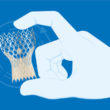In recent years, there has been a steady increase in the use of transcatheter aortic valve replacement (TAVR) in younger patients, with an average age of 74 years, as observed in US medical records. This trend goes alongside encouraging durability results, as demonstrated in the 10-year NOTION study, where structural valve degeneration (SVD) with first-generation<a href="https://solaci.org/en/2023/10/27/tct-2023-evolut-low-risk-4-year-follow-up/" title="Read more" >...</a>
TCT 2023 | The WATCH-TAVR Study
In the TVT registry, around 40% of the patients eligible for transcatheter aortic valve replacement (TAVR) had atrial fibrillation, and there were high levels of adverse events after starting anticoagulant treatment, especially with oral anticoagulants (VKAs), primarily due to bleeding. The purpose of this study was to assess the feasibility, safety, and efficacy of combined<a href="https://solaci.org/en/2023/10/27/tct-2023-the-watch-tavr-study/" title="Read more" >...</a>
OBSERVANT II: Post TAVR 30-Day and 6-Month Stroke Predictors
Despite stroke rate has declined since the early days of transcatheter aortic valve replacement (TAVR), it remains significant, reaching 1% to 3% 30 days after procedure. Since TAVR has seen a progressive expansion to the low risk and young populations, identifying risk factors in patient selection and management is crucial for us to prevent stroke. <a href="https://solaci.org/en/2023/10/20/observant-ii-post-tavr-30-day-and-6-month-stroke-predictors/" title="Read more" >...</a>
Cause of Cardiac Death after TAVR at Present
Cardiac failure (CF) and sudden cardiac death (SCD) stand out as two of the main causes of death in patients with aortic stenosis. Although transcatheter aortic valve intervention has shown higher survival, these two continue to be the main conditions leading to patient death at followup. In its early days, TAVR also showed benefits, but<a href="https://solaci.org/en/2023/10/11/cause-of-cardiac-death-after-tavr-at-present/" title="Read more" >...</a>
TAVR in Asymptomatic or Minimally Symptomatic Patients: 30-Day Results
Aortic valve replacement (AVR) is recommended for symptomatic aortic stenosis (AS), while close monitoring is the advised strategy for asymptomatic patients, unless they have elevated aortic gradients, reduced ejection fraction, or abnormal stress tests. However, the optimal timing for AVR remains uncertain, especially in light of recent evidence suggesting that AS patients showing signs of<a href="https://solaci.org/en/2023/10/06/tavr-in-asymptomatic-or-minimally-symptomatic-patients-30-day-results/" title="Read more" >...</a>
TAVR Durability at 5 Years in Intermediate Risk Patients
TAVR has been shown beneficial in patients across the risk spectrum. The PARTNER 2 SAPIEN 3 (P2S3i) study on intermediate risk patients was the first to show TAVR superiority vs SAVR when using the transfemoral approach. SAVR durability has been shown in different analysis but, except for a few reports, TAVR durability at long term<a href="https://solaci.org/en/2023/07/11/tavr-durability-at-5-years-in-intermediate-risk-patients/" title="Read more" >...</a>
VASC-OBSERVANT II Substudy: Impact of Vascular Complications after TAVR
At present, transcatheter aortic valve replacement (TAVR) has become increasingly common to treat severe symptomatic aortic stenosis, with the transfemoral approach being the most common access strategy, associated to better outcomes vs. other access sites. Even though vascular complication rates (VC) have dropped given increased operation experience and improved devices, such as the use of<a href="https://solaci.org/en/2023/06/27/vasc-observant-ii-substudy-impact-of-vascular-complications-after-tavr/" title="Read more" >...</a>
TAVR: Does HALT Affect Follow-Up?
Transcatheter aortic valve replacement (TAVR) in low-risk patients has been shown to be superior or noninferior in randomized studies, but the presence of valvular thrombosis, in its different forms, has not been well analyzed, nor is there much information on its impact on evolution. Researchers conducted an analysis of the LTR study that included 200<a href="https://solaci.org/en/2023/06/07/tavr-does-halt-affect-follow-up/" title="Read more" >...</a>
Impact of Right Ventricular Pacing in Patients with Permanent Pacemaker Implantation after TAVR
Permanent pacemaker implantation (PPI) is a relevant complication in patients undergoing transcatheter aortic valve replacement (TAVR) despite there being new devices. The current information on the long term impact of this complication remains unclear and recent evidence suggests post-TAVR ventricular pacing (VP) might be associated to higher risk of all-cause mortality and hospitalization for cardiac<a href="https://solaci.org/en/2023/05/28/impact-of-right-ventricular-pacing-in-patients-with-permanent-pacemaker-implantation-after-tavr/" title="Read more" >...</a>
EuroPCR 2023 | ACURATE Neo2: Results After 5 Years
The ACURATE Neo2 valve is an evolution of the first-generation ACURATE Neo valve with a low rate of pacemaker implantation and a decrease in paravalvular leak, also compatible with the 14F introducer. This prospective study included patients with symptomatic severe aortic stenosis at high surgical risk who underwent ACURATE Neo2 valve implantation. The primary endpoint<a href="https://solaci.org/en/2023/05/23/europcr-2023-acurate-neo2-results-after-5-years/" title="Read more" >...</a>







